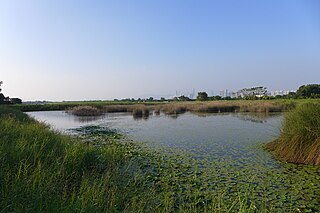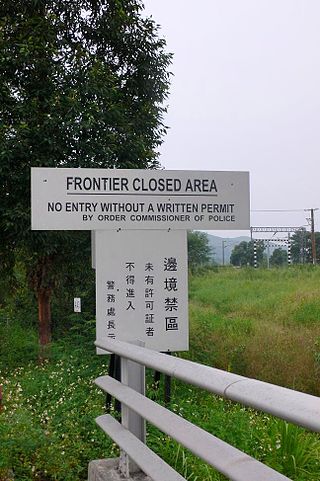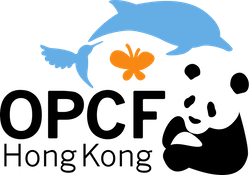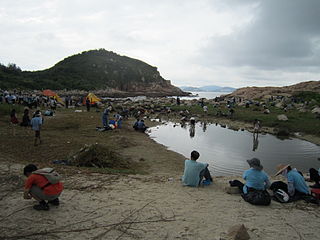
The Indo-Pacific humpback dolphin is a species of humpback dolphin inhabiting coastal waters of the eastern Indian and western Pacific Oceans. This species is often referred to as the Chinese white dolphin in mainland China, Macau, Hong Kong, Singapore and Taiwan as a common name. Some biologists regard the Indo-Pacific dolphin as a subspecies of the Indian Ocean humpback dolphin which ranges from East Africa to India. However, DNA testing studies have shown that the two are distinct species. A new species, the Australian humpback dolphin, was split off from S. chinensis and recognized as a distinct species in 2014. Nevertheless, there are still several unresolved issues in differentiation of the Indian Ocean-type and Indo-Pacific-type humpback dolphins.
The ecology of Hong Kong is mostly affected by the results of climatic changes. Hong Kong's climate is seasonal due to alternating wind direction between winter and summer.

Yuen Long District is one of the districts of Hong Kong. Located in the northwest of the New Territories, it had a population of 662,000 in 2021.

Mai Po Marshes (Chinese: 米埔濕地; Hong Kong Hakka: Mi3bu4 Sip5ti4) is a nature reserve located in San Tin near Yuen Long in Hong Kong. it is within Yuen Long District.

Hoi Ha Wan or Jone's Cove is a bay at the north of Sai Kung Peninsula. It is part of Hoi Ha Wan Marine Park, a marine park in Hong Kong. The village of Hoi Ha is located on the innermost shore of Hoi Ha Wan.

Island House is a historical building located on Island House Lane, Yuen Chau Tsai (元洲仔), Tai Po, New Territories, Hong Kong.

Ocean Park Hong Kong, commonly known simply as Ocean Park, is an animal theme park in Hong Kong. Covering an area of 91.5 hectares in Wong Chuk Hang, it is the largest theme park by area in Hong Kong, and is also the city's second oldest theme park, after the now-defunct Lai Chi Kok Amusement Park.

Marine debris, also known as marine litter, is human-created solid material that has deliberately or accidentally been released in seas or the ocean. Floating oceanic debris tends to accumulate at the center of gyres and on coastlines, frequently washing aground, when it is known as beach litter or tidewrack. Deliberate disposal of wastes at sea is called ocean dumping. Naturally occurring debris, such as driftwood and drift seeds, are also present. With the increasing use of plastic, human influence has become an issue as many types of (petrochemical) plastics do not biodegrade quickly, as would natural or organic materials. The largest single type of plastic pollution (~10%) and majority of large plastic in the oceans is discarded and lost nets from the fishing industry. Waterborne plastic poses a serious threat to fish, seabirds, marine reptiles, and marine mammals, as well as to boats and coasts.

Out of the total 1,092 km2 of land in Hong Kong, three-quarters is countryside, with various landscapes including beaches, woodlands, and mountain ranges being found within the small territory. Most of Hong Kong's parks have abundant natural diversity, usually containing over 1,000 species of plants.

Deep Bay is a bay between Yuen Long District, in the New Territories, Hong Kong and the city of Shenzhen in Guangdong Province. It is otherwise known as Hau Hoi Wan in Hong Kong, and Shenzhen Bay in Mainland China.

The Frontier Closed Area, established by the Frontier Closed Area Order, 1951, and 1984 is a regulated border zone in Hong Kong that extended inwards from the border with Mainland China.
The Marine Parks Ordinance protects and conserves the marine environment and a rich collection of aquatic animals and plants, such as corals, sea grasses and dolphins. The ordinance also provides the legal framework for the designation, control and management of marine parks and marine reserves. The Marine Parks and Marine Reserve Regulation provides for the prohibition and control of certain activities in marine parks and marine reserve.

The Ocean Park Conservation Foundation, Hong Kong, often referred to by its initialism OPCFHK, is a registered charitable non-governmental organisation under the Ocean Park Corporation. It was established on 1 July 2005, following the merger of the former Ocean Park Conservation Foundation (OPCF) and The Hong Kong Society for Panda Conservation (HKSPC).

Plastic pellet pollution is a type of marine debris originating from the plastic particles that are universally used to manufacture large-scale plastics. In the context of plastic pollution, these pre-production plastic pellets are commonly known as 'nurdles'. These microplastics are created separately from the user plastics they are melted down to form, and pellet loss can occur during both the manufacturing and transport stages. When released into the open environment, they create persistent pollution both in the oceans and on beaches. About 230,000 tonnes of nurdles are thought to be deposited in the oceans each year, where they are often mistaken for food by seabirds, fish and other wildlife. Due to their small size, they are notoriously difficult to clear up from beaches and elsewhere.
World Wide Fund for Nature-India, better known by its abbreviation WWF-India, Established as a Charitable Trust in 1969, has been devotedly working to protect and secure natural heritage and ecology for more than 50 years. It has an autonomous office, with the Secretariat based in New Delhi and various state, divisional and project offices spread across India.
The Hong Kong Bird Watching Society is an environmental non-governmental organization dedicated to the conservation of birds and their habitats in Hong Kong, a territory on the southern coast of China. It is a BirdLife International affiliated organization. The emblem of the HKBWS is the Chinese egret which visits Hong Kong on migration and used to breed in the territory.

Ocean Recovery Alliance (ORA) is a 501c3 registered non-profit organization in California, and registered charitable organization in Hong Kong, with the aim to use new technologies, innovations, creativity and collaborations to solve issues that face the health of the ocean today.

The Hong Kong plastic disaster refers to a marine pollution event in adjacent waters of Hong Kong in 2012. Typhoon Vicente hit Hong Kong and its adjacent waters on 23 July 2012, causing seven containers, six of which were loaded with polypropylene pellets produced by China Petroleum & Chemical Corporation (Sinopec), in a container ship of China Shipping Container Lines (CSCL) to fall into and float on the Hong Kong south waters after the storm. Some containers were destroyed by waves, releasing plastic pellets into the ocean, which became marine debris scattering across Hong Kong's south waters and beaches with water flow, resulting in wide environmental and ecological pollution and threatening local fishery.

Ng Cho-nam, SBS, JP, was a Hong Kong environmental studies scholar and conservationist who taught as an associate professor within the Department of Geography at the University of Hong Kong. He served as a top advisor on numerous Hong Kong government committees in areas of conservation, sustainable development, environmental protection, urban planning, and was an active member in various environmental NGOs. He was the director of the Conservancy Association from 2000 to 2019.

The Mediterranean Sea has been defined as one of the seas most affected by marine plastic pollution.

















